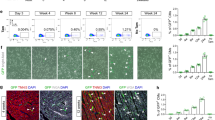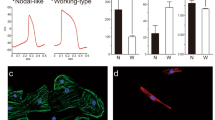Abstract
The purification, renewal and differentiation of native cardiac progenitors would form a mechanistic underpinning for unravelling steps for cardiac cell lineage formation, and their links to forms of congenital and adult cardiac diseases1,2,3. Until now there has been little evidence for native cardiac precursor cells in the postnatal heart4. Herein, we report the identification of isl1+ cardiac progenitors in postnatal rat, mouse and human myocardium. A cardiac mesenchymal feeder layer allows renewal of the isolated progenitor cells with maintenance of their capability to adopt a fully differentiated cardiomyocyte phenotype. Tamoxifen-inducible Cre/lox technology enables selective marking of this progenitor cell population including its progeny, at a defined time, and purification to relative homogeneity. Co-culture studies with neonatal myocytes indicate that isl1+ cells represent authentic, endogenous cardiac progenitors (cardioblasts) that display highly efficient conversion to a mature cardiac phenotype with stable expression of myocytic markers (25%) in the absence of cell fusion, intact Ca2+-cycling, and the generation of action potentials. The discovery of native cardioblasts represents a genetically based system to identify steps in cardiac cell lineage formation and maturation in development and disease.
This is a preview of subscription content, access via your institution
Access options
Subscribe to this journal
Receive 51 print issues and online access
$199.00 per year
only $3.90 per issue
Buy this article
- Purchase on Springer Link
- Instant access to full article PDF
Prices may be subject to local taxes which are calculated during checkout





Similar content being viewed by others
References
Chien, K. R. Stem cells: lost in translation. Nature 428, 607–608 (2004)
Epstein, J. A. Developing models of DiGeorge syndrome. Trends Genet. 17, S13–S17 (2001)
Chien, K. R. & Olson, E. C. Converging pathways and principles in heart development and disease: CV@CSH. Cell 110, 153–162 (2002)
Rosenthal, N. Prometheus's vulture and the stem cell promise. N. Engl. J. Med. 346, 267–274 (2003)
Bischoff, R. in Myogenesis (eds Engel, A. G. & Franszini-Armstrong, C.) 97–118 (McGraw-Hill, New York, 1994)
Seale, P. & Rudnicki, M. A. A new look at the origin, function, and “stem-cell” status of muscle satellite cells. Dev. Biol. 218, 115–124 (2000)
Beltrami, A. P. et al. Adult cardiac stem cells are multipotent and support myocardial regeneration. Cell 114, 763–776 (2003)
Oh, H. et al. Cardiac progenitor cells from adult myocardium: Homing, differentiation, and fusion after infarction. Proc. Natl Acad. Sci. USA 100, 12313–12318 (2003)
Balsam, L. B. et al. Haematopoietic stem cells adopt mature haematopoietic fates in ischemic myocardium. Nature 428, 668–675 (2004)
Murry, C. E. et al. Hematopoietic stem cells do not transdifferentiate into cardiac myocytes in myocardial infarcts. Nature 428, 664–668 (2004)
Nygren, J. M. et al. Bone marrow-derived hematopoietic cells generate cardiomyocytes at a low-frequency through cell fusion, but not transdifferentiation. Nature Med. 10, 494–501 (2004)
Cai, C.-L. et al. Isl1 identifies a cardiac progenitor population that proliferates prior to differentiation and contributes a majority of cells to the heart. Dev. Cell 5, 877–889 (2003)
Srinivas, S. et al. Cre reporter strains produced by targeted insertion of EYFP and ECFP into the ROSA26 locus. BMC Dev. Biol. 1, 4 (2001)
Soriano, P. Generalized lacZ expression with the ROSA26 Cre reporter strain. Nature Genet. 21, 70–71 (1999)
Verrou, C., Zhang, Y., Zurn, C., Schamel, W. W. & Reth, M. Comparison of the tamoxifen regulated chimeric Cre recombinases MerCreMer and CreMer. Biol. Chem. 380, 1435–1438 (1999)
Danielian, P. S., Muccino, D., Rowitch, D. H., Michael, S. K. & McMahon, A. P. Modification of gene activity in mouse embryos in utero by tamoxifen-inducible form of Cre recombinase. Curr. Biol. 8, 1323–1326 (1998)
Schwenk, F., Kuhn, R., Angrand, P. O., Rajewsky, K. & Stewart, A. F. Temporally and spatially regulated somatic mutagenesis in mice. Nucleic Acids Res. 26, 1427–1432 (1998)
Martin, C. M. et al. Persistent expression of the ATP-binding cassette transporter, Abcg2, identifies cardiac SP cells in the developing and adult heart. Dev. Biol. 265, 262–275 (2004)
Wurmser, A. E. et al. Cell fusion-independent differentiation of neural stem cells to the endothelial lineage. Nature 430, 350–356 (2004)
Voura, E. B., Jaiswal, J. K., Mattoussi, H. & Simon, S. M. Tracking metastatic tumor cell extravasation with quantum dot nanocrystals and fluorescence emission-scanning microscopy. Nature Med. 9, 993–998 (2004)
Maltsev, V. A., Ji, G. J., Wobus, A. M., Fleischmann, B. K. & Hescheler, J. Establishment of β-adrenergic modulation of L-type Ca2+ current in the early stages of cardiomyocyte development. Circ. Res. 84, 136–145 (1999)
He, J.-Q., Ma, Y., Lee, Y., Thomson, J. A. & Kamp, T. J. Human embryonic stem cells develop into multiple types of cardiac myocytes. Circ. Res. 93, 32–39 (2003)
D'Amour, K. A. & Gage, F. H. Are somatic stem cells pluripotent or lineage-restricted? Nature Med. 8, 213–214 (2002)
Pashmforoush, M. et al. Nkx2.5 pathways and congenital heart disease: loss of ventricular myocyte lineage specification leads to progressive cardiomyopathy and complete heart block. Cell 117, 373–386 (2004)
Hayashi, S. & McMahon, A. P. Efficient recombination in diverse tissues by tamoxifen-inducible form of Cre: a tool for temporally regulated gene activation/inactivation in the mouse. Dev. Biol. 244, 305–318 (2002)
Acknowledgements
We thank W. Giles for discussions and comments on the real-time Ca2+ measurements and electrophysiology, the National Center for Microscopy and Imaging Research at UCSD for the use of the high-speed multi-photon laser-scanning microscope (Bio-Rad RTS2000) and custom plug-ins for the ImageJ software (H. Hakozaki, S. Chow and M. Ellisman), the UCSD Cancer Center Digital Imaging Shared Resource for deconvolution microscopy (S. McMullen and J. Feramisco). We would like especially to acknowledge D. Young for his expertise and help in the FACS sorting analysis (UCSD Cancer Center Flow Cytometry Laboratories). This work was supported by the NIH and the Jean Le Ducq Foundation. K.-L.L. is a Heisenberg Scholar of the German Research Foundation.
Author information
Authors and Affiliations
Corresponding authors
Ethics declarations
Competing interests
The authors declare that they have no competing financial interests.
Supplementary information
Supplementary Table 1
Evaluation of human, post-natal isl1+ progenitors in atrial tissue following pediatric surgical correction of diverse congenital heart defects. (DOC 33 kb)
Supplementary Table 2
Comparison of isl1+ cardioblasts, cardiac sca-1+ cells and cardiac side population (SP) cells. (DOC 39 kb)
Supplementary Figure 1
Rare subset of isl1+ cardiac progenitors in double heterozygous isl1-mER-Cre-mER/R26R hearts in 2 month old animals in the outflow tract (a) and the right atrium (b). (PDF 133 kb)
Supplementary Figure 2
Amplification of rat isl1+ progenitors on cardiac mesenchymal cells in vitro (a, b) and their phenotypic characterization (c). (PDF 116 kb)
Supplementary Video
Video demonstrating the [Ca2+]i transients of differentiated β-Gal+ progenitors. (MOV 9207 kb)
Supplementary Video legend
Real time calcium imaging of FACS-sorted β-Gal+ progenitors differentiated in coculture. (DOC 21 kb)
Supplementary Method Section
Methods regarding flow cytometry analysis, co-culture experiments, immunocytochemistry and lacZ staining, RT-PCR, detection of [Ca2+]i transients and electrophysiological action potential recordings are described in the supplementary method section. (DOC 35 kb)
Rights and permissions
About this article
Cite this article
Laugwitz, KL., Moretti, A., Lam, J. et al. Postnatal isl1+ cardioblasts enter fully differentiated cardiomyocyte lineages. Nature 433, 647–653 (2005). https://doi.org/10.1038/nature03215
Received:
Accepted:
Issue Date:
DOI: https://doi.org/10.1038/nature03215
This article is cited by
-
The benign nature and rare occurrence of cardiac myxoma as a possible consequence of the limited cardiac proliferative/ regenerative potential: a systematic review
BMC Cancer (2023)
-
The splanchnic mesenchyme is the tissue of origin for pancreatic fibroblasts during homeostasis and tumorigenesis
Nature Communications (2023)
-
The second heart field: the first 20 years
Mammalian Genome (2023)
-
Reprogramming of fibroblasts into expandable cardiovascular progenitor cells via small molecules in xeno-free conditions
Nature Biomedical Engineering (2022)
Comments
By submitting a comment you agree to abide by our Terms and Community Guidelines. If you find something abusive or that does not comply with our terms or guidelines please flag it as inappropriate.



